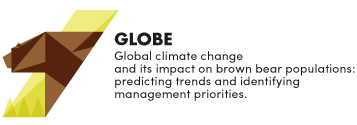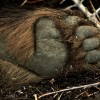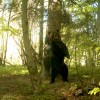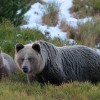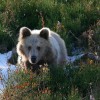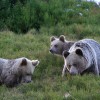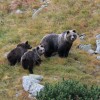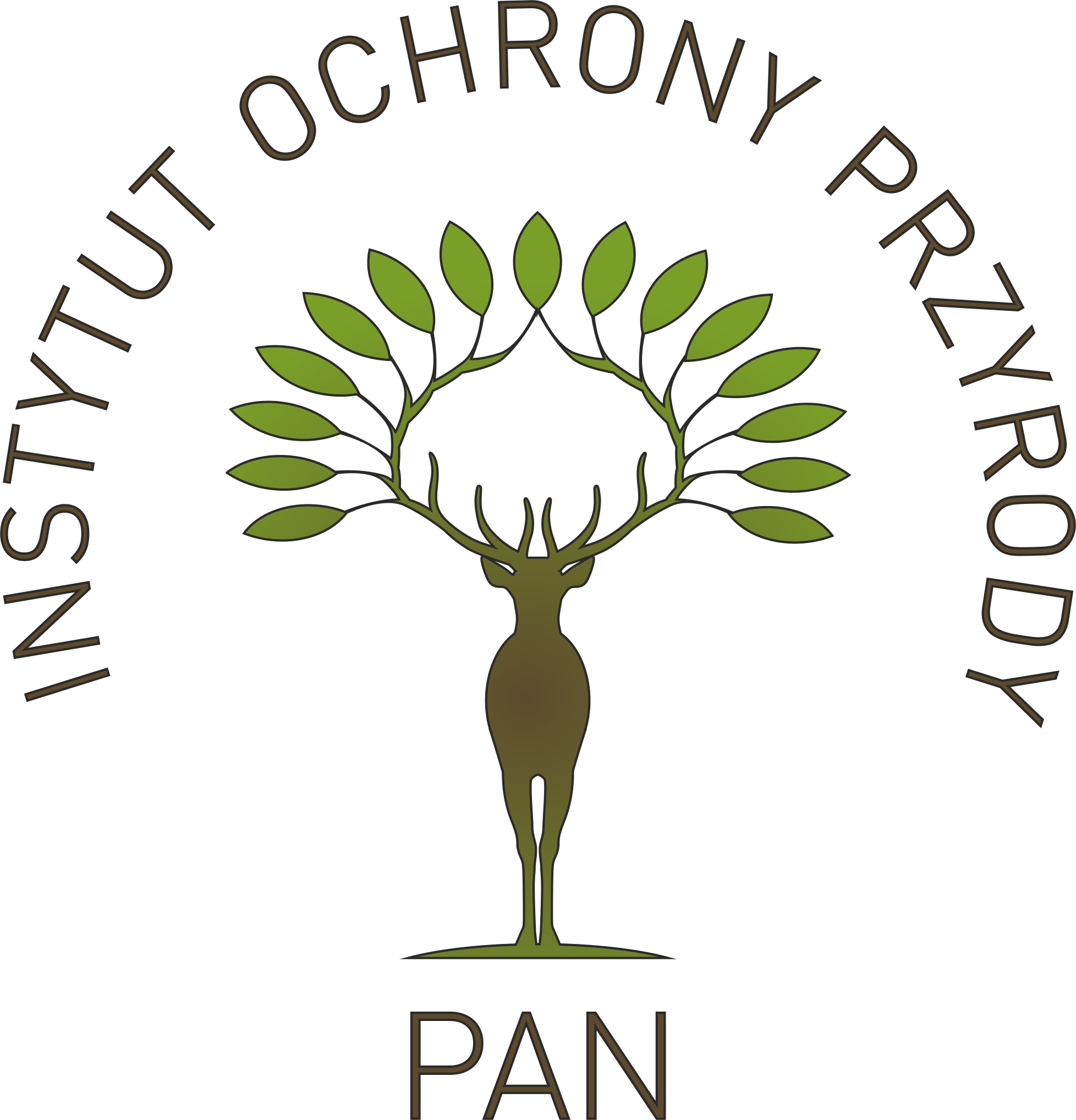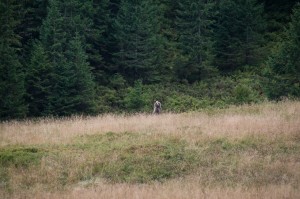 The brown bear is a species with large spatial requirements, low reproductive rates and very sensitive to habitat loss and fragmentation and to human disturbance, especially in winter. The impact of human persecution on the current distribution range of the species has been significant, so the habitats presently used by bears do not necessarily represent the most suitable for the species. The areas occupied by bears must provide not only abundant food, but also the opportunity to cover. In adult individuals there is a considerable sexual dimorphism in body size, males being bigger. Within and between-year variation of individual body weight is also very large.
The brown bear is a species with large spatial requirements, low reproductive rates and very sensitive to habitat loss and fragmentation and to human disturbance, especially in winter. The impact of human persecution on the current distribution range of the species has been significant, so the habitats presently used by bears do not necessarily represent the most suitable for the species. The areas occupied by bears must provide not only abundant food, but also the opportunity to cover. In adult individuals there is a considerable sexual dimorphism in body size, males being bigger. Within and between-year variation of individual body weight is also very large.

Bears are omnivores. The composition of their food varies depending on the local food availability and season. At the biogeographical scale, their diet also changes with the location (latitude, longitude and altitude) and mainly with environmental factors (temperature and snow cover). In the forests of the temperate zone, fruits and invertebrates prevail in bear diet, whereas in the tundra vertebrates do. In some locations, food of anthropogenic origin (e.g. supplemental food, fruits from orchards) represents the main component of bear diet.
The annual cycle of bears is divided into four physiological states: winter dormancy, hypophagia, normal activity and hyperphagia. Far north, winter dormancy may last even longer than 7 months; however, in populations from warmer regions some individuals may stay active throughout the year. Activity during winter has been documented for example in the Cantabrian population. The length of winter dormancy varies among bear populations and, as a general pattern, the higher the latitude, the longer the period of hibernation. Pregnant females enter winter den sites the first and emerge from them the last. The duration of winter denning also depends on the age of individuals. Adult males are the last to den and the first to leave their dens. Females with cubs stay relatively close to their den sites until mid-May. Although bears usually show a high degree of fidelity to their denning areas, winter dens are reused only exceptionally.
The mating season of the brown bear usually begins at the beginning of May and lasts till July. The individuals at reproductive age belonging to both sexes mate multiple times often with several partners. Cubs are born during winter dormancy from December to March. At the time of birth, cubs are bald and blind and weigh about 350-500 grams. The average litter size ranges from 1.3-2.6 cubs and varies among populations. Cubs in one litter can be sired by different fathers. The reproductive period of females can last from 3 to 29 years of age, with the highest productivity at the age of 8-9 years. In most populations, the mother nurses her offspring for 1.4 to 3.5 years. The largest mortality among brown bears occurs in the first year of life. Infanticide by males is considered to be a major cause of cub mortality, at least in some populations. In most brown bear populations the main cause of mortality is of human origin. In nature, the oldest bears observed were over 30 years; the oldest captive bear was 50 years old, and the oldest female 42 years.
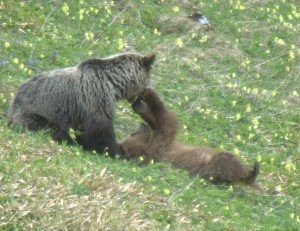 Brown bears are not territorial, and their home ranges significantly overlap. This overlapping is greatest in the case of females, especially if they are kin-related. Home ranges of males are usually larger, encompassing those of several females. Annual home range sizes vary considerably among populations. In Europe, the home ranges of males vary from 128 km2 in Croatia to 1,600 km2 in central Sweden, whereas for females vary from 58 km2 to 225 km2, respectively. Dispersing young males may have annual home ranges up to 12,000 km2. In Scandinavia, females at the age of 2 to 4 years move on average 28 km from the center of their natal home range, while 4-year old males disperse an average distance of 119 km. The maximum dispersal distance recorded is 467 km for males and 90 km for females.
Brown bears are not territorial, and their home ranges significantly overlap. This overlapping is greatest in the case of females, especially if they are kin-related. Home ranges of males are usually larger, encompassing those of several females. Annual home range sizes vary considerably among populations. In Europe, the home ranges of males vary from 128 km2 in Croatia to 1,600 km2 in central Sweden, whereas for females vary from 58 km2 to 225 km2, respectively. Dispersing young males may have annual home ranges up to 12,000 km2. In Scandinavia, females at the age of 2 to 4 years move on average 28 km from the center of their natal home range, while 4-year old males disperse an average distance of 119 km. The maximum dispersal distance recorded is 467 km for males and 90 km for females.
Photos by Tomasz Zwijacz-Kozica and Ole Frobert ©
Climate change is affecting our environment, and thus our societies and economy. Actions to reduce our greenhouse gas emissions and minimize the impacts of climate change have been taken at national and international level. Climate change is one of the main global threats to biodiversity of our times. In interaction with non-climate factors, particularly human-driven habitat changes, it represents the main force driving species decline and extinctions nowadays. Understanding how species respond to climate change is pivotal for the conservation of biodiversity and ecosystem management.
There is considerable variation in species responses and in the way different regions in the globe are affected by climate change. New species have colonized previously “cool” regions, whereas some Arctic species have contracted their range and other species have moved to higher latitudes and elevations. Phenological shifts suggest a trend towards spring advancement, like earlier frog breeding, bird nesting, first flowering, tree budburst and arrival of migrant birds and butterflies. Shifts in the seasonal timing can differ across trophic levels and result in a mismatch between resources and consumers, such as life cycles of predators and their prey, herbivorous insects and their host plants, parasitoids and their host insects, and insect pollinators and flowering plants, which may finally lead to population declines. Apart of these two climate-induced shifts (range and phenology), evolutionary adaptation to climate change at the local scale, including greater dispersal rates or broader diet at the range limits, has also been documented.
The impact of climatic changes in boreal and mountain ecosystems in Europe has started to be evident. In Sweden, treelines have shifted towards north. Vascular plant species in boreal-temperate mountain regions in Europe have moved upslope. Whereas the boreal region is projected to lose few plant species and gain many others from immigration, an excess of vegetal species loss is predicted for the mountains regions of Europe, including the Carpathians. The recent trend of increasingly warm winters in northern Europe and Scandinavia cause female red deer Cervus elaphus to become smaller, which may lead to reduced fecundity. The range of Fennoscandia birds is expected to suffer large reductions in the next decades due to climate changes, enhaced by the Arctic Ocean representing a barrier to northwards movements. Due to climate change, in synergy with fragmentation levels and barriers to migration in Europe, an important portion of European mammal species are expected to lose more than 30% of their current distribution.
Large carnivores inhabiting northern latitudes may be good indicators of ongoing climate and environmental changes. The best example is the polar bear, which has been object of much research on climate change impacts and become the iconic symbol of a melting Arctic. Its sister species, the brown bears, may also be a model species in climate change research, particularly in the boreal and alpine ecosystems; however, it has received little attention in this respect. The brown bear is an omnivorous species which shows low reproduction rates and goes into hibernation. Their ecology and physiology are largely influenced by climatic conditions. Recent observations from the brown bear Carpathian population suggest modification in their typical behaviors, probably linked to changes in the winter conditions. For example, non-hibernating bears are being increasingly observed during winter in many areas in Europe. Winter is a period of low food availability, and hibernation an adaptation to those conditions. Shortening of the bear denning period or increased bear activity during winter may, therefore, produce a trophic mismatch. Mistiming with crucial bear foods during hyperphagia, when bears have to gain weight for winter denning and successful reproduction, may also have important consequences. Climate-induced changes in bear denning, foraging patterns or potential range shifts into new areas may also affect the occurrence of human-bear conflicts and how bears are perceived and valued.
Climate is the “average weather” in a place over many years. It includes patterns of temperature, precipitation (rain or snow), humidity, wind and seasons. Weather is the events that happen each day in our atmosphere. While weather can change in some hours, climate used to take thousands, even million years to change.
Climate change is defined by the Intergovernmental Panel on Climate Change (IPCC) as a change in the state and properties of the climate that persists for an extended period, typically decades or longer. It refers to any change in climate over time, whether due to natural variability or as a result of human activity. However, current climate change refers to a change of climate that is attributed directly or indirectly to human activity, in addition to natural climate variability, and that alters the composition of the global atmosphere. This is the definition used by the United Nations Framework Convention on Climate Change (UNFCCC).
Climate change is a global issue. The 2007 report by IPCC shows unequivocal warming of the climate. The Earth's climate has warmed by an average of 0.74°C (+0.56°C to 0.92°C) in the last 100 years (1906-2005). The greater rate of warming has been from 1976 onwards. Eleven of the last twelve years (1995-2006) rank among the twelve warmest years in the instrumental record of global surface temperature (since 1850). IPCC predicts a warming of about 0.2°C per decade in the next 20 years. It is very likely that cold days, cold nights and frosts have become less frequent over most land areas. Snow and ice extent decreases are also observed. Satellite data show that annual average Arctic sea ice extent has shrunk by 2.7% per decade. Mountain glaciers and snow cover have declined in both hemispheres. Since 1900, seasonally frozen ground has decreased by about 7% in the Northern Hemisphere, with decreases in spring of up to 15%. Increases in sea level are consistent with warming and the global average sea level rose at an average rate of about 3.1 mm per year from 1993 to 2003.
Climate change is projected to be particularly strong in northern latitudes. Boreal and mountain regions are likely to be especially affected by climate change. In Europe, mountainous areas will face glacier retreat, reduced snow cover and winter tourism, and extensive species losses (in some areas up to 60% under high emissions scenarios by 2080). An increase in precipitation has also been observed in northern Europe (1900-2005). The frequency of heat waves and heavy precipitation events are likely to increase as well.
Project GLOBE (POL-NOR/198352/85/2013) is funded from Norway Grants in the Polish-Norwegian Research Programme operated by the National Centre for Research and Development.
The aim of the Polish-Norwegian Research Programme is to reduce economic and social differences and to promote bilateral cooperation between the two countries, Poland and Norway, through popularization and support of scientific research. The Programme prioritize funding for research and development in the following areas: environment, climate change including polar research, health, social sciences and bilateral relations, including the issues of migration, social cohesion, the role of minorities and the social dimension of sustainable development, gender equality and work-life balance, carbon capture and storage.
GLOBE project consortium comprises 5 partners:
Institute of Nature Conservation, Polish Academy of Sciences (PL; project promoter) www.iop.krakow.pl
Norwegian University of Life Sciences (NO) www.nmbu.no
Telemark University College, Department of Environmental and Health Studies (NO) www.hit.no
University of Warsaw, Faculty of Economic Sciences (PL) www.wne.uw.edu.pl
Norwegian Institute for Nature Research (NO) www.nina.no
and one third party: Tatra National Park (PL) www.tpn.pl
To learn about brown bears behavior, how they move through and use the landscape and habitat, what they eat and if their diet changed over last centuries, where they rest, how long they sleep during the winter or maybe why some of them stay active, how far they move and disperse, how they respond to human activities and pressure on the environment, we need to use various research techniques, including radio- and GPS-telemetry, stable isotope analyses, hormonal analyses. We will also try to study human-bear relations using methods used in social sciences and economy.
WP1. Climate change effects on brown bear winter ecology and distribution range
We will assess recent changes in the climatic conditions of boreal and alpine ecosystems, particularly in the current area of distribution of brown bears in Scandinavia and the northern Carpathians. Our main question is whether bear winter ecology (denning patterns, activity and movements in winter) is being affected by climate changes. We will also explore whether bear distribution has shifted due to climate change. We will use these results to model the effects of expected climatic changes on these parameters. This WP will be based on bear trapping and equipping with GPS collars, analyses of long-term climate and bear winter data, and building climate envelope and predictive models.
WP2. Climate change effects on brown bear foraging ecology
This WP will explore climate-induced changes in brown bear foraging patterns by assessing long-term changes in brown bear diet and in the temporal and spatial availability of bear foods. The first will be done by stable isotope analysis of samples of potential bear foods and bear hairs. The collection of bear hairs covers last 30 years and will be completed with historical samples from museums and samples from trapped bears. The second goal will require the analysis of historical and recent spatial information. This will allow us to assess and predict trophic mismatches and identify mechanisms for bear adaptation to climate change.
WP3. Climate and human-mediated effects on brown bear stress ecology
Here we will investigate how climate conditions, in interaction with human-related factors, such as human disturbance or habitat modification, affect the baseline stress levels of brown bears. This WP also will use the bear hair samples mentioned above; in many cases they come from repeated sampling of the same individuals along their lives. This will allow to explore the link between stress levels and individual life histories (fitness). Hair samples will be analysed for cortisol determination as a measure of long-term stress. This will be coordinated with WP2 to relate stress to diet and habitat features. Hormonal analysis of faecal samples of known bears collected during this and previous projects will be also conducted to assess short-term stress.
WP4. Socio-economic aspects of climate-driven changes in human-bear relations
Climate-induced effects on brown bear populations, such as population expansion to new areas or non-hibernating bears, may increase the probability of occurrence of human-bear encounters. This WP will explore the economic and human dimensions of projected changes in human- bear relations using stated preference methods (choice experiments). We will assess how bears are valued in Norway and Poland and how this relates to the national compensation systems.
WP5. Project management and dissemination
This WP will coordinate WPs and activities and monitor the development of the project by quality control of accomplished tasks, deliverables and milestones. One of the main tasks will be dissemination of the project findings to all interested sectors. It will also focus on the integration of these multidisciplinary approaches in the assessment of climate change impacts on large carnivore populations. This WP will facilitate communication and information exchange, promote a nice working environment and set the bases for a continued cooperation in future between the Norwegian and Polish teams. Main tasks relate to project website and media communication, organization of project workshops, reporting and preparing final practical guidelines for managers.
The main goal of the GLOBE project is to assess the effects of climate change on the Carpathian and Scandinavian brown bear populations and how these effects are mediated by human-related factors, and disentangle the mechanisms for climate-change adaptation in large carnivores from boreal and alpine ecosystems.
Within the GLOBE project, we want to:
- determine the effects of climate changes on brown bear winter ecology,
- build a climate envelope model for the brown bear and predict the species distribution and potential range shifts under different climate scenarios and in different regions and time periods,
- assess climate and human-induced changes on brown bear foraging patterns, predict future trends and identify potential trophic mismatches,
- investigate how climate conditions affect the short- and long-term physiological stress of bear populations (relationship between stress levels and individual fitness),
- evaluate the socio-economic aspects of climate-driven changes in human-bear relations,
- disentangle the mechanisms for brown bear adaptation to climate changes,
- disseminate to the broad audience and target groups (wildlife managers) the message of the effects of climate change on a charismatic and familiar species like the brown bear, predict consequences and trends, and ultimately provide guidelines for brown bear population management.
Climate change is one of the main global threats to biodiversity. Understanding how species respond to climate change is pivotal for biodiversity conservation and ecosystem management. Boreal and alpine regions are likely to be especially affected by climate change, particularly in Europe.
Large carnivores inhabiting these regions may be good indicators of ongoing climate and environmental changes. Similarly to the polar bear Ursus maritimus in the Arctic, the brown bear Ursus arctos may be a model species in climate change research, particularly in boreal and alpine ecosystems. Recent observations suggest a shortening of the bear winter denning period and, thus, potential trophic mismatches. Climate-induced changes in denning, foraging patterns or potential range shifts into new areas may affect the occurrence of human-bear conflicts and how bears are perceived and valued.
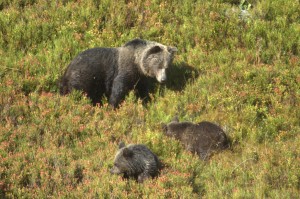
Our main goal is to assess the current and future effects of climate change on two brown bear populations (Scandinavian and Carpathian) and to disentangle the mechanisms for climate-change adaptation in large carnivores from northern ecosystems. We hypothesize that climate-related factors, in interaction with non-climate factors, particularly human-driven habitat changes, are strongly affecting brown bear wintering patterns, physiological state, foraging ecology and human-bear relations.
To address these research questions, we will combine different methods, such as GPS telemetry, stable isotope and hormonal analysis, climate envelope and predictive models, spatial analysis and socio-economic surveys. The analyses of long-term datasets (c.a. 30 years for the Scandinavian population) at the population and individual level provide a unique opportunity to advance in our understanding of climate change impacts on biodiversity and ecosystem functioning. This project may also have important implications for brown bear management and conservation.
Photo by Tomasz Zwijacz-Kozica
